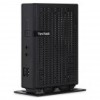ViewSonic SC-T45 SC-T35 / SC-T45 ViewSonic Device Management (English) - Page 7
Introduction, Features, Supported Platforms
 |
View all ViewSonic SC-T45 manuals
Add to My Manuals
Save this manual to your list of manuals |
Page 7 highlights
Overview Introduction 1.1 Introduction Desktop virtualization provides a new perspective to reconsider the design and implementation of an IT infrastructure. In a desktop virtualization infrastructure, a station is no longer a cumbersome desktop, but simply an endpoint device for users to access delivery services from the server(s). With the introduction of the desktop virtualization technologies, you can considerably benefit from: • On-demand application / desktop access • Centralized management of work environments • Drastically reduced endpoint software/hardware issues • Simplified system maintenance • Improved system security • More scalability with low-cost endpoint devices But still you need a powerful software for managing a large number of endpoint devices in a desktop virtualization infrastructure. The ViewSonic Device Manager console is designed to fill the need. It enables you to remotely deploy, manage, update clients, and assist users from a single computer. You can manage and update clients simply and quickly in groups with a flexible and secure mechanism. Additionally, you can remotely assist users in resolving problems or configuring local settings. 1.2 Features The key features of ViewSonic Device Manager are: • Pushing custom settings to a large number of clients • Updating firmware and installing software packages for clients • Taking client snapshots for quick system backup and recovery • Rebooting, powering off, and waking clients through the local network • Helping users to troubleshoot problems remotely • Identifying clients and managing IT assets with automatically-captured client information 1.3 Supported Platforms ViewSonic Device Manager supports the following operating systems: • Windows 7 / Vista / XP • Windows Server 2003 / 2008 / 2008 R2 2















